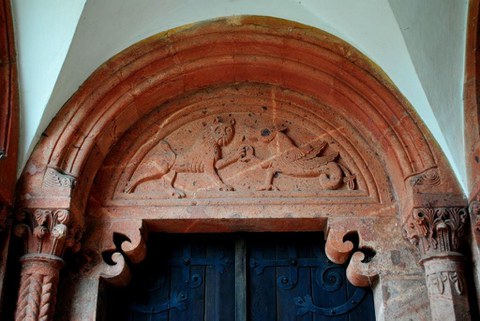Nov 23, 2022
Rochlitzer Porphyrtuff from Northwest Saxony is the first German natural stone to be included in the series of "IUGS Heritage Stones" on the initiative of the Technische Universität Dresden

Romanisches Portal der Stiftskirche in Wechselburg aus RPT (12. Jh.)
Since the early 12th century, the building and sculptural rock Rochlitzer Porphyrtuff has been quarried near the small Saxon town of Rochlitz. Due to its strong color and interesting structure, it is a unique building stone in Germany that has shaped the region's architectural heritage since the early days of its use. As a building material, the stone has been used in numerous important buildings, such as the Romanesque monastery church in Wechselburg, the Leipzig City Hall, the Villa Esche of the architect Henry van de Velde in Chemnitz (1911) or for the redesign of the tomb of Immanuel Kant (1924) in Königsberg (today Kaliningrad / Russia). The facade of the new church building of the Provost Church of St. Trinitatis in Leipzig, which was inaugurated in 2015, is also completely covered with Rochlitz porphyry tuff.
The natural stone from Saxony has now been named a "Heritage Stone" by the International Union of Geological Sciences (IUGS). This is the first time that a German natural stone has been among the 32 rocks from 17 countries that have been awarded this title. It now stands in a row with well-known rocks such as the Italian Carrara marble, the Portland limestone from Great Britain or the Spanish slate.
The title "Heritage Stone" honors a natural stone material that is closely associated with the building culture of an architecturally rich landscape and the history of the stonemasonry and stone sculpture trades in Germany. As part of the activities of the National Geopark "Porphyry Land" and other local actors, the international recognition should contribute to the increased awareness not only of the stone and its geology, but also of the cultural landscape associated with it.
The International Union of Geological Sciences (IUGS) is one of the largest scientific organizations. With 121 national members, the global association represents over one million geoscientists. IUGS promotes and supports the study of geological problems of international importance and geoscience education, as well as interdisciplinary cooperation in the geosciences. It cooperates with UNESCO, among others, in numerous international scientific programs. One of the focal points of her work is the identification, documentation as well as the protection and popularization of important sites and testimonies of the "geo-heritage". Within this framework, it has been designating globally significant natural stones used for architecture and sculpture as "IUGS Geoheritage Stones" according to standardized criteria since 2016.
The inclusion of the Rochlitz Porphyry Tuff in the series of the world's most important natural stones is due to the initiative of Prof. Heiner Siedel from the Institute of Geotechnical Engineering at the Faculty of Civil Engineering at TU Dresden.
